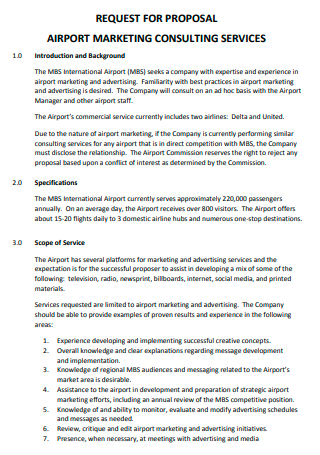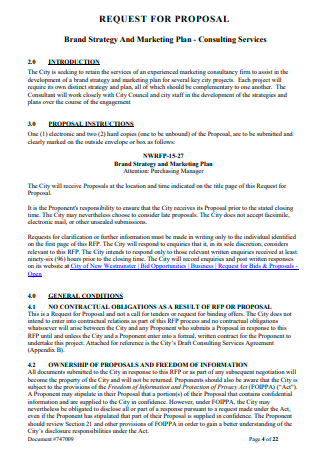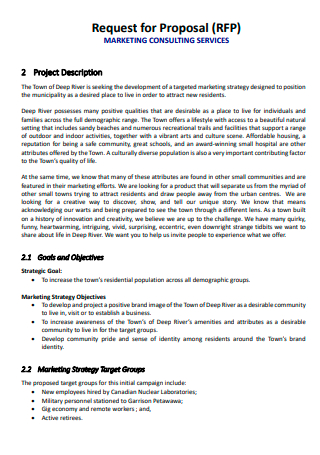3+ Sample Marketing Consulting Proposal
FREE Marketing Consulting Proposal s to Download
3+ Sample Marketing Consulting Proposal
What Is a Marketing Consulting Proposal?
What Are the Benefits of a Marketing Consulting Proposal?
Elements of a Marketing Consulting Proposal
Steps in Writing a Marketing Consulting Proposal
FAQs
How do I protect myself as the consultant?
What is a consultant’s fee?
Can a consultant be sued?
What is the value of business advice?
How long should a proposal be?
What do consultants add to a company?
What Is a Marketing Consulting Proposal?
In the field of marketing consulting, a proposal is a document that contains consulting advice for a specific company. If a company is experiencing difficulties that necessitate consultation, a plan will be produced to detail how the difficulties will be resolved. In larger organizations, it is extremely common for consultants to be hired to provide an objective viewpoint on a number of matters, including private employment concerns.
Other templates are available on our website, and you can use them whenever you need them. They are as follows: business consulting proposal, bid proposal, security bid proposal, project investment proposal, printable strategic plan, club strategic plan, consulting contract proposal, quality control agreement, customer invoice, payment invoice, and other similar templates are available. This post will not only provide you with templates but will also provide you with important information that you need to know in order to complete your template.
What Are the Benefits of a Marketing Consulting Proposal?
Proposals are documents that detail any research or ideas that are important to a specific topic in question, such as a company proposal. Business proposals that explain new products frequently include information about the funds required to launch the items, a list of the individuals who will be in charge of the product development, and a strategy for how the product will be delivered to the public. Take, for example, When it comes to making an executive choice, all of this information is really beneficial.
1. Approaches that Are Different
A marketing concept proposal is a document that is commonly written by key members of an organization’s management team. Small businesses may only create one proposal, whereas major firms may write dozens or even hundreds of proposals in a given period of time. It is possible that each proposal will be written by a different CEO or management team in order to acquire a diverse range of new thoughts and ideas It is the goal of marketing proposals to provide alternatives ways to a system or project that have not been developed by the company’s management team. You should also see our Data Sharing Agreement.
2. The Project’s Budget
It is possible to produce a budget for a project or idea by clearly defining it in the proposal and demonstrating to the executives how much it will cost to design, conceive, develop, and implement the project. For example, the marketing department may desire to produce a new product that makes use of novel materials. Costs associated with importing new materials, costs associated with producing the product, and prices at which the product must be sold to cover production costs and profit should all be included in the proposal. In order to avoid incurring any unforeseen charges or taxes down the road, a general budget should be exact so that the business does not experience any surprises.
3. Recognize the Problems
Another advantage of creating a marketing proposal report is that it serves as a full summary of the entire process, which is really useful. Continuing with the preceding example, the marketing plan may suggest that a comprehensive budget has been set and that the necessary actors for the product’s development have been identified, but that no marketing methods have been investigated. When reviewing proposals, executives will look for any sections that are missing information or require additional attention in order for the plan to be considered in its entirety.
4. The Project’s Advantages
When writing each proposal, the author provides a list of positive outcomes that the organization would experience or gain as a result of accepting and implementing the proposal. While projections or product benefits are frequently simply optimistic guesses based on sales prices, product trends, and production costs, they are frequently computed to reflect realistic results in order to avoid misleading customers.
Elements of a Marketing Consulting Proposal
The most effective marketing consulting proposals are those that are both visually appealing and logically organized. Section two of this chapter is devoted to describing the structure of a well-written consulting proposal. While it is totally free to acquire example marketing consulting proposal templates, there is nothing quite like learning how to design a consulting proposal from the ground up on your own time. Take into consideration the following factors to guarantee that your journey runs as smoothly as it possibly can:
Steps in Writing a Marketing Consulting Proposal
Start by taking a look at our sample consulting proposal template, which you may feel free to download if you like the format. If you like, you can use it as a starting point for developing your own template. If you’re going to design a custom template, it’s best to start at the beginning with nothing. Despite the fact that the approaches are basic, creating the document involves a significant amount of time and effort. You must perform considerable study and carefully prepare how you will present the material in your presentation. Consider the following tips for putting together a winning proposal.
-
1. Face-to-face or over Phone Communication with your Client Is Preferable
You will not be able to construct an effective consulting proposal until you first speak with your prospective customer. Make every attempt to schedule a phone conversation for this discussion; if at all possible, arrange to meet in person. When it comes to getting to know your consumer and their consultation needs, an email is acceptable; but, letting them see your face and/or hear your voice will aid you in building trust. You should also see our service contract proposal.
-
2. Be Cognizant of their Difficulties as well as their Requirements
In order for your proposal to be more appealing, you must first understand the issues and pain points of your prospective client. While using a consulting proposal template can help you get the job done faster, the information in your proposals should be adjusted for each client and their specific requirements, not the other way around. Follow up with additional phone calls or meetings to have a better knowledge of your client and the services that they desire. You should also see our IT services proposal
-
3. Obtain Specifics by Inquiring
A successful proposal accurately depicts the scope and specifications of the project in order to ensure that all parties are on the same page at the same time. Don’t forget to ask your client about the most appropriate timeframe, budget, objectives, and outcomes for your project. Both in terms of presenting your services to new clients and in terms of providing your clients with a more accurate image of how you and your client will operate together, these facts are crucial.
-
4. In Lieu of Consultant Input, Place Greater Emphasis on Customer Outcomes
While it may be tempting to concentrate solely on your credentials and experience, your consulting proposal should emphasize the benefits that your customer will obtain as a result of working with you, rather than the other way around. Provide your client with as much detail as possible about the value and outcomes that they can expect from your services. Apart from that, avoid using clichés and generic terminology. Consider making an attempt to use the same language they used throughout your conversations; this will resonate with them and reflect that you paid attention to what they were saying.
-
5. Keep it to a Minimum
When it comes to consulting proposals, quality consistently outperforms quantity by a wide margin. Maintain a succinct proposal in order to effectively outline the scope and expectations of the project and to avoid wasting time. Provide your client with no reason to reject your proposal in favor of another consultant’s – instead, keep your proposal brief and engaging to read. The normal length of a paper is one to two pages, to give you some perspective.
-
6. Soliciting Customer Feedback
It is important for all parties to have input into the composition of a consultation proposal, which is why it should be a two-way street. As you work on your proposal, make sure to address any questions or concerns you have with your prospective client. Once it has been completed, send it to your client for evaluation and feedback.
A marketing consulting proposal is a written document that outlines the nature, scope, and timeline of a consulting assignment in the field of marketing consulting. A marketing consulting proposal, similar to a salesperson’s presentation to a prospect, emphasizes the client’s problem while positioning you, the consultant, as the answer to that problem. Having the capacity to design a brief, concise, and clear consulting proposal can make or break your ability to convert prospective clients into customers. You should also see our Data Sharing Agreement.
FAQs
How do I protect myself as the consultant?
Discuss your professional boundaries and ask your client to do the same. Agree on working hours, response times, and scheduling calls, meetings, and Skype sessions.
What is a consultant’s fee?
Consulting contracts define a consultant’s services. Self-employed consultants, frequently work with numerous companies rather than just one.
Can a consultant be sued?
The customer could sue the consultant for damages for staff errors, lost productivity, or other losses.
What is the value of business advice?
Business consultants help firms achieve their goals by providing business analysis, solutions, and tracking.
How long should a proposal be?
A recommendation should be brief. A page or two would be ideal for many. Many would go further.
What do consultants add to a company?
A consultant’s three superpowers are independence, neutrality, and exposure to a wide range of experiences.
In marketing, proposals are critical. Setting expectations for the client relationship is critical since there are so many specialties to manage and so many channels, deliverables, and KPIs to monitor. A strategic framework, overarching goals, and potentially even smaller milestones against which you intend to be measured may be included in a marketing consulting proposal.




